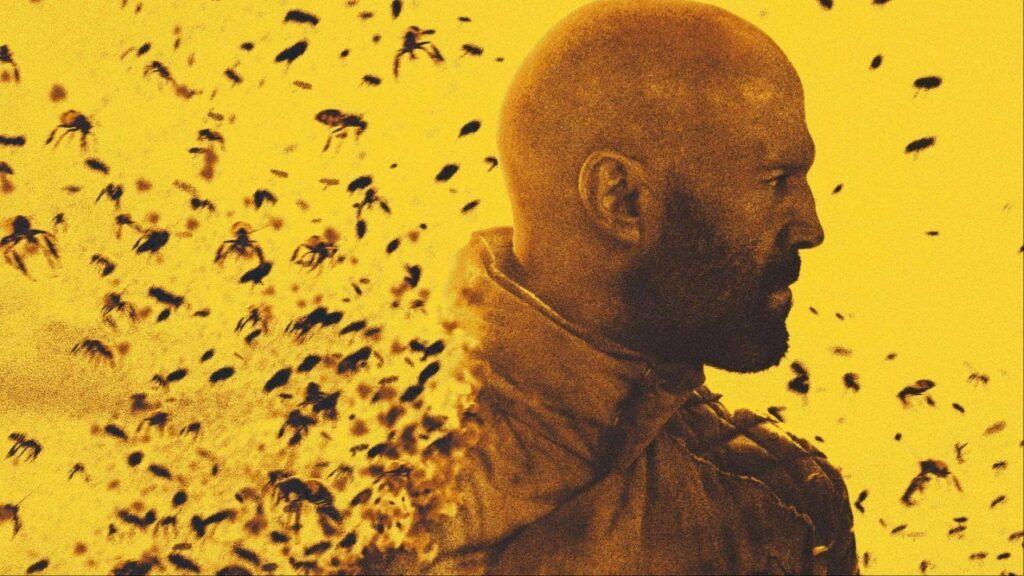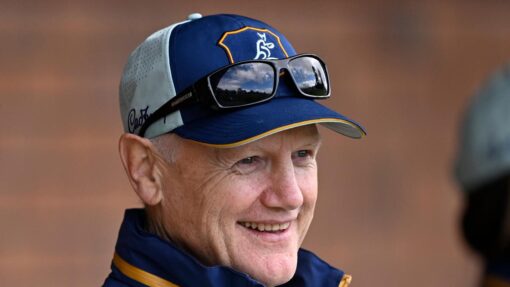Review: The Beekeeper

Screen reviews by Christopher Gist
Amongst the surprising starter careers that invariably lead to life as an unbeatable hitman or ruthless heavy – The Painter, The Mechanic, The Accountant, The Transporter, The Tax Collector – Jason Statham adds a further twist, springboarding from collecting fresh honey to becoming the deadly Beekeeper. He is so unbeatable that, as co-star Jeremy Irons points out once or twice in the film, once you’ve disturbed The Beekeeper, just sit back and wait to die.
This latest actioner from Statham and director David Ayer begins when Statham’s landlady Eloise (Phylicia Rashad, The Cosby Show) is scammed online of all her retirement money, including two million from a charitable account she oversees. Just before that, Statham’s character Adam Clay has told her that she is the only person in his life who ever cared for him. In actioners, this kind of loose talk is often code for the character being destined to die (DTD), or to at least getting very badly hurt and disappearing from the film until a hospital bed denouement. It’s Option A here, and Eloise ends up suiciding. Coincidentally, Eloise’s daughter is FBI Agent Verona Parker (Emmy Raver-Lampman, The Umbrella Academy) who has had no luck in the past prosecuting online scammers, but who quickly becomes a central part of the investigation as a frenemy to Clay. No conflict of interest here for the FBI.
Given that the general structure of this sort of vengeance tale is hundreds of years old, none of the plot reveals I mention will be unexpected. In this case, Eloise’s death forces Clay out of retirement. Rather like Liam Neeson in Taken, Clay has the very particular set of skills essential to ramping up the body count. We learn Clay worked for a deeply hidden spy’s spy mob known only as The Beekeepers, a security apparatus so veiled that none of the other TLA (three letter acronym) agencies have heard of it. Clay calls up his Beekeeper mates who immediately help him locate the scamming conglomerate that even the FBI has not been able to trace.
Enter Jeremy Irons, ex-CIA boss and now protector of the film’s ultimate villain Derek and associated scammers. Iron’s character Wallace Westwyld is forced by sexual interest in Derek’s mum to do what he’d rather not: go up against a Beekeeper. Derek is played by Josh Hutcherson (The Hunger Games), and Derek has corruptly applied some deeply secret CIA algorithms to his successful fraud empire. In interview with moviefone, Hutcherson describes his character as a “scumbag” and “rich crypto bro”, and Derek is very much that as he lives a rarefied life of privately cheffed meals and new-age massages. Since Derek’s vast network of loathsome fellow crypto bros is spectacularly successful in ripping off America’s superannuated grandparents, it seems Derek is DTD.
Thankfully, there’s a ton of action before Derek has his one scene with Clay and dies, and the shoot-outs and punch-ups along the way are delivered in some laugh-out-loud ways. The team is clearly enjoying themselves, David Ayer saying the appeal for him lay in the fact that The Beekeeper is “really a classic action, escapist, thrill ride … to have the opportunity to make a fun movie that I know an audience is going to love was something I couldn’t say no to”. However, having observed action and fight scenes on a number of Australian productions, I’ve seen how much time, planning, and rehearsal is required for even small stunts. As much fun as it may have been, this is clearly no small outing for The Beekeeper production team. Statham evidently does many (if not all) of his own stunts, of which Hutcherson saysthat Statham is “so on top of it and consistent, professional and the choreography that he keeps in his head, and the fact that he’s able to do that, and have his lines and nail his mark every time. He’s a fine, fine, fine-tuned machine”. There are many moving parts to all of this and the experienced team delivers the large-scale action with aplomb.
The set-pieces range from blowing up a multi-storey office building to sawing off fingers in burning barns. Villains are inventively driven off bridges while tied to tension straps, cut in half by falling elevators, or hoisted by the neck to their death by a ninja-like Adam Clay hiding in a roof cavity. In these many confrontations, Statham successfully applies his jumping front kicks and elbow work to legions of men with machine guns. Not infrequently someone is foolishness enough to try a mere handgun on Clay, only to find it disassembled and in pieces on the ground before they’ve remembered there is a trigger to pull.
Statham even manages to outfox a fellow Beekeeper who confronts him with a military grade weapon on the tray of her pick-up. It’s the M134 Minigun that Schwarzenegger hefted in Predator (nothing mini about it), and described by the Internet Movie Firearms Database as a “six-barrelled, electrically-driven rotary gun originally designed by General Electric”. This thing accesses 4,500 rounds, all of which Statham deftly skips from on his way to blowing up a petrol station and, to be fair, towards a new note of pastiche in the film. The fellow Beekeeper assigned to kill him appears in a bright pink cape-like overcoat and uber-70s makeup and is an easy fit for second banana to any of the old-school Batman villains. It is at this point when Clay evades 4,500 rounds that audiences know they can relax – our hero is very much destined to live. So much so, in fact, that when he confronts another Batmanesque major villain in the form of a yellow-haired one-legged South African, a combat knife to Clay’s guts is a matter of no consequence.
By contrast, the more straight-laced suit and tie and handgun world of Statham’s The Transporter series of films spends time developing a central relationship between Statham and his charge. While some of The Transporter stunts are fantastical, these films nonetheless consider to some degree what goes on between people, building some level of emotional connection between the characters. The Beekeeper is less focussed on any central relationship Statham’s character Clay may have, and is more focussed on delivering action wholly separate from, dare I say, reality.
It feels odd, then, to remark on the socio-politic of the film, given we’re here mostly for the front-kicks and giggles. But the script appears to want to say something about community-making, and injustice, power, and online scamming. Ayer comments that “There’s a lot of cool allegories and this very interesting mythology behind bees, and this idea of taking care of the hive, taking care of society, protecting the hive and protecting society”*. But, even on that level, the world of the film contradicts the actual reality identified by numerous newspaper articles, true-life documentaries, and criminal investigations regarding the who and where of the type of cybercrime that The Beekeeper dramatises.
I took all of the beekeeper/hive allegory talk as a slightly different way to repackage a vengeance actioner, and it has clearly worked for Statham’s large audience. If you’re after an action thriller with a bit more to say about corruption, then Ayer’s Training Day is on my shortlist of best cop films. As for The Beekeeper, enjoy the biff all the way to Clay’s cliff-side escape in a Bond-like wetsuit and perhaps wonder, as I did, how many times Statham and his agent asked when Barbara Broccoli would be calling.
* For moviefone’s full interview with David Ayer and Josh Hutcherson see https://www.moviefone.com/news/the-beekeeper-interview-josh-hutcherson-and-david-ayer/



